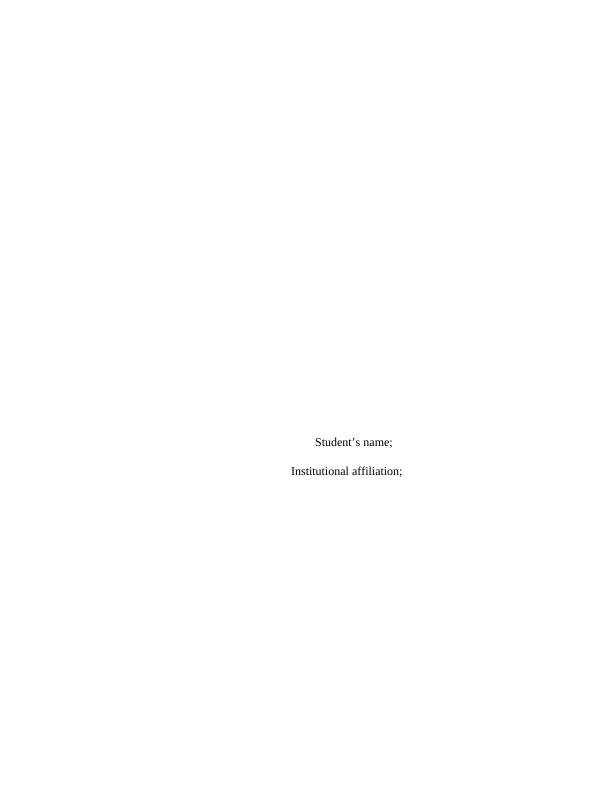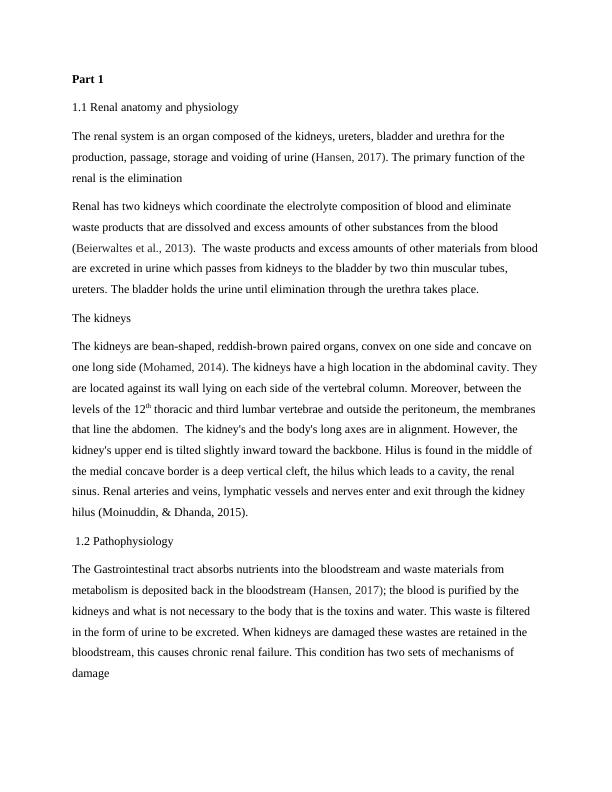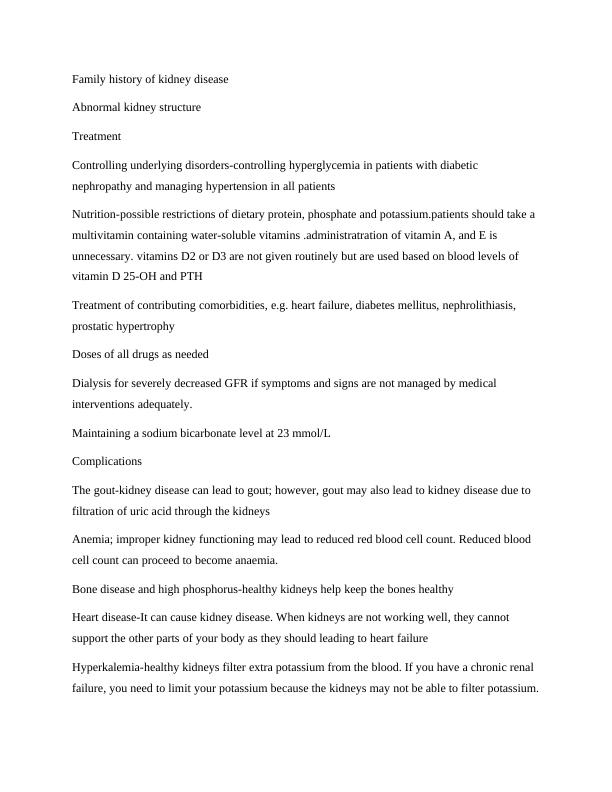Renal Anatomy, Physiology, Pathophysiology, and Treatment
Added on 2022-11-10
11 Pages2897 Words244 Views
Student’s name;
Institutional affiliation;
Institutional affiliation;

Part 1
1.1 Renal anatomy and physiology
The renal system is an organ composed of the kidneys, ureters, bladder and urethra for the
production, passage, storage and voiding of urine (Hansen, 2017). The primary function of the
renal is the elimination
Renal has two kidneys which coordinate the electrolyte composition of blood and eliminate
waste products that are dissolved and excess amounts of other substances from the blood
(Beierwaltes et al., 2013). The waste products and excess amounts of other materials from blood
are excreted in urine which passes from kidneys to the bladder by two thin muscular tubes,
ureters. The bladder holds the urine until elimination through the urethra takes place.
The kidneys
The kidneys are bean-shaped, reddish-brown paired organs, convex on one side and concave on
one long side (Mohamed, 2014). The kidneys have a high location in the abdominal cavity. They
are located against its wall lying on each side of the vertebral column. Moreover, between the
levels of the 12th thoracic and third lumbar vertebrae and outside the peritoneum, the membranes
that line the abdomen. The kidney's and the body's long axes are in alignment. However, the
kidney's upper end is tilted slightly inward toward the backbone. Hilus is found in the middle of
the medial concave border is a deep vertical cleft, the hilus which leads to a cavity, the renal
sinus. Renal arteries and veins, lymphatic vessels and nerves enter and exit through the kidney
hilus (Moinuddin, & Dhanda, 2015).
1.2 Pathophysiology
The Gastrointestinal tract absorbs nutrients into the bloodstream and waste materials from
metabolism is deposited back in the bloodstream (Hansen, 2017); the blood is purified by the
kidneys and what is not necessary to the body that is the toxins and water. This waste is filtered
in the form of urine to be excreted. When kidneys are damaged these wastes are retained in the
bloodstream, this causes chronic renal failure. This condition has two sets of mechanisms of
damage
1.1 Renal anatomy and physiology
The renal system is an organ composed of the kidneys, ureters, bladder and urethra for the
production, passage, storage and voiding of urine (Hansen, 2017). The primary function of the
renal is the elimination
Renal has two kidneys which coordinate the electrolyte composition of blood and eliminate
waste products that are dissolved and excess amounts of other substances from the blood
(Beierwaltes et al., 2013). The waste products and excess amounts of other materials from blood
are excreted in urine which passes from kidneys to the bladder by two thin muscular tubes,
ureters. The bladder holds the urine until elimination through the urethra takes place.
The kidneys
The kidneys are bean-shaped, reddish-brown paired organs, convex on one side and concave on
one long side (Mohamed, 2014). The kidneys have a high location in the abdominal cavity. They
are located against its wall lying on each side of the vertebral column. Moreover, between the
levels of the 12th thoracic and third lumbar vertebrae and outside the peritoneum, the membranes
that line the abdomen. The kidney's and the body's long axes are in alignment. However, the
kidney's upper end is tilted slightly inward toward the backbone. Hilus is found in the middle of
the medial concave border is a deep vertical cleft, the hilus which leads to a cavity, the renal
sinus. Renal arteries and veins, lymphatic vessels and nerves enter and exit through the kidney
hilus (Moinuddin, & Dhanda, 2015).
1.2 Pathophysiology
The Gastrointestinal tract absorbs nutrients into the bloodstream and waste materials from
metabolism is deposited back in the bloodstream (Hansen, 2017); the blood is purified by the
kidneys and what is not necessary to the body that is the toxins and water. This waste is filtered
in the form of urine to be excreted. When kidneys are damaged these wastes are retained in the
bloodstream, this causes chronic renal failure. This condition has two sets of mechanisms of
damage

1) Initiating mechanisms which are specific to the underlying etiology, e.g. immunology diseases
and inflammatory mediators in conditions like glomerulonephritis or when renal tubules are
exposed to toxins
2) Progressive mechanisms which include hyperfiltration and hypertrophy of the remaining
healthy nephrons that are a common effect of long-term reduction of renal mass (Helal et al.
2012)
Chronic renal failure is a long-standing, deterioration of renal function that progresses with time
(Webster et al., 2012). Symptoms develop slowly and in advanced stages include; anorexia,
nausea, vomiting, stomatitis, fatigue, muscle twitches and cramps, water retention and seizures
Chronic renal failure is a diminished renal reserve or renal insufficiency, which may progress to
renal failure, as renal failure loses function, there are few noticeable abnormalities because the
remaining tissue increases its performance (Levey, & Coresh, 2012).
Declining renal function leads to interference with the kidneys' ability in maintaining fluid and
electrolyte balance in the body. There is an early declination of the kidney's ability to concentrate
urine. The decline is followed by a decrease in the ability to excrete excess phosphate, acid and
potassium.when renal failure is advanced, the ability to effectively dilute or concentrate urine is
lost thus urine osmolality is usually fixed, and urinary volume does not respond readily to
variations in water intake.
Risk factors
Diabetes
High blood pressure
Cardiovascular disease
Smoking
Obesity
Being African-American, Native Americans or Asian-Americans
and inflammatory mediators in conditions like glomerulonephritis or when renal tubules are
exposed to toxins
2) Progressive mechanisms which include hyperfiltration and hypertrophy of the remaining
healthy nephrons that are a common effect of long-term reduction of renal mass (Helal et al.
2012)
Chronic renal failure is a long-standing, deterioration of renal function that progresses with time
(Webster et al., 2012). Symptoms develop slowly and in advanced stages include; anorexia,
nausea, vomiting, stomatitis, fatigue, muscle twitches and cramps, water retention and seizures
Chronic renal failure is a diminished renal reserve or renal insufficiency, which may progress to
renal failure, as renal failure loses function, there are few noticeable abnormalities because the
remaining tissue increases its performance (Levey, & Coresh, 2012).
Declining renal function leads to interference with the kidneys' ability in maintaining fluid and
electrolyte balance in the body. There is an early declination of the kidney's ability to concentrate
urine. The decline is followed by a decrease in the ability to excrete excess phosphate, acid and
potassium.when renal failure is advanced, the ability to effectively dilute or concentrate urine is
lost thus urine osmolality is usually fixed, and urinary volume does not respond readily to
variations in water intake.
Risk factors
Diabetes
High blood pressure
Cardiovascular disease
Smoking
Obesity
Being African-American, Native Americans or Asian-Americans

Family history of kidney disease
Abnormal kidney structure
Treatment
Controlling underlying disorders-controlling hyperglycemia in patients with diabetic
nephropathy and managing hypertension in all patients
Nutrition-possible restrictions of dietary protein, phosphate and potassium.patients should take a
multivitamin containing water-soluble vitamins .administratration of vitamin A, and E is
unnecessary. vitamins D2 or D3 are not given routinely but are used based on blood levels of
vitamin D 25-OH and PTH
Treatment of contributing comorbidities, e.g. heart failure, diabetes mellitus, nephrolithiasis,
prostatic hypertrophy
Doses of all drugs as needed
Dialysis for severely decreased GFR if symptoms and signs are not managed by medical
interventions adequately.
Maintaining a sodium bicarbonate level at 23 mmol/L
Complications
The gout-kidney disease can lead to gout; however, gout may also lead to kidney disease due to
filtration of uric acid through the kidneys
Anemia; improper kidney functioning may lead to reduced red blood cell count. Reduced blood
cell count can proceed to become anaemia.
Bone disease and high phosphorus-healthy kidneys help keep the bones healthy
Heart disease-It can cause kidney disease. When kidneys are not working well, they cannot
support the other parts of your body as they should leading to heart failure
Hyperkalemia-healthy kidneys filter extra potassium from the blood. If you have a chronic renal
failure, you need to limit your potassium because the kidneys may not be able to filter potassium.
Abnormal kidney structure
Treatment
Controlling underlying disorders-controlling hyperglycemia in patients with diabetic
nephropathy and managing hypertension in all patients
Nutrition-possible restrictions of dietary protein, phosphate and potassium.patients should take a
multivitamin containing water-soluble vitamins .administratration of vitamin A, and E is
unnecessary. vitamins D2 or D3 are not given routinely but are used based on blood levels of
vitamin D 25-OH and PTH
Treatment of contributing comorbidities, e.g. heart failure, diabetes mellitus, nephrolithiasis,
prostatic hypertrophy
Doses of all drugs as needed
Dialysis for severely decreased GFR if symptoms and signs are not managed by medical
interventions adequately.
Maintaining a sodium bicarbonate level at 23 mmol/L
Complications
The gout-kidney disease can lead to gout; however, gout may also lead to kidney disease due to
filtration of uric acid through the kidneys
Anemia; improper kidney functioning may lead to reduced red blood cell count. Reduced blood
cell count can proceed to become anaemia.
Bone disease and high phosphorus-healthy kidneys help keep the bones healthy
Heart disease-It can cause kidney disease. When kidneys are not working well, they cannot
support the other parts of your body as they should leading to heart failure
Hyperkalemia-healthy kidneys filter extra potassium from the blood. If you have a chronic renal
failure, you need to limit your potassium because the kidneys may not be able to filter potassium.

End of preview
Want to access all the pages? Upload your documents or become a member.
Related Documents
Anatomy and Physiology of Urinary System: A Comprehensive Overviewlg...
|4
|781
|454
Understanding Renal System and Chronic Kidney Disease: A Case Scenariolg...
|15
|3555
|444
Chronic Renal Failure: Pathophysiology, Treatment Options, and Medicationslg...
|11
|2815
|369
Pathophysiology of Chronic Kidney Failure and Hemodialysis Treatmentlg...
|11
|3011
|335
Study on Renal System and Chronic Renal Failurelg...
|12
|3346
|43
Nursing Assignment: Question and Answerslg...
|16
|4940
|83
